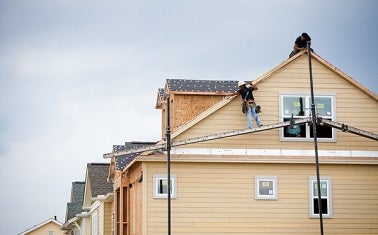
Workers install solar panels on a home in Austin’s Mueller neighborhood, a project of Pecan Street Inc.
As I stroll through the Mueller neighborhood in Austin, TX, I see parks, fountains, two-door garage homes – absolutely nothing out of the ordinary – just your average suburban neighborhood. But I know better.
Under the surface of this community lives the most “connected” network of energy customers in the country. Mueller is the launching site for Pecan Street Inc.’s living smart-grid research project and, according to a recent issue of Time Magazine, America’s Smartest City.
The Time article features homeowners who generate and make money on their solar panels, while enjoying access to minute-by-minute energy use data. It shows their sense of stewardship and empowerment.
The story does a good job summarizing the mission of Pecan Street, of which Environmental Defense Fund is a founding member and environmental partner. But the author misses one important point when he writes: “The rest of America may never realize Mueller’s vision for the future.”
The truth is, we have cause for a lot more optimism than that. We believe that the Mueller model is scalable and EDF is working hard to make sure the rest of the country can also enjoy the benefits of a smarter, cleaner home.
A living laboratory
Together with the City of Austin, the University of Texas, Austin Energy, and other institutions, we set out in 2008 to reinvent a neighborhood to become a model for America’s clean energy future. One of the goals of the project is for the neighborhood to decrease carbon emissions by more than 60 percent compared to its Austin peers.
But the Mueller neighborhood, the locus of Pecan Street, is foremost a laboratory of ideas and technologies that includes more than 250 households, 200 of which have rooftop solar and over 50 electric vehicles.
In June of 2013, Pecan Street opened its three-story Pike Powers Laboratory and Center for Commercialization, where researchers test everything from electric vehicles to energy storage technologies. And Pecan Street is expanding.
The project already includes residents throughout Austin, Dallas, San Diego, and Boulder – and it’s just the beginning. Despite different climates and needs, these cities show that the opportunity for scaling the Mueller model is huge if we allow flexibility and meet regional needs.
Communities with abundant sunshine can benefit from rooftop solar panels that face west, while others with less sun may invest in community energy storage. Those in windy parts of the country may find success by encouraging residents to shift their power needs to the night when the wind blows more.
Utilities have the power
Pecan Street is proving that energy independence, comfort, reliability, and sustainability all go hand-in-hand – if you have the right electric utility.
Austin Energy is undoubtedly one of the country’s more forward-thinking utilities, which is, in part, why Mueller residents are enjoying negative utility bills. They understand that the world is changing and are prepared and ready for the challenge.
Meanwhile, other utilities around the country are fighting hard to protect the status quo and creating roadblocks for homeowners looking to gain energy independence. To counter this movement, EDF is helping state regulators rethink the country’s century-old utility business model.
Instead of paying utilities to build more dirty power plants, utilities should incentivize energy efficiency upgrades and distributed generation, like rooftop solar panels. The cleanest and cheapest electricity, after all, is the energy we don’t use.
Scalable innovation
Energy efficiency and demand response – a program that rewards people for using less electricity, rather than turning on coal-fired power plants to meet electricity demands – can take us a long way.
So can financing tools that eliminate steep upfront costs. EDF’s On-bill repayment has opened the door for homeowners of all incomes to harness clean energy – a requisite for growing the market. We estimate that over a 12-year timeframe on-bill repayment could help spur $87 billion in clean energy investments nationwide.
Such programs, along with knowledge from the Mueller neighborhood, can bring innovation far beyond Austin.
Pecan Street’s main goal above all else is to be a proving ground where appliances can be tested in a real-world situation before they go to market. It’s a place where we can see how the growth in electric vehicles affects the electric grid, and where we can find new revenue streams for utilities as the world changes around them.
The key to this new path is flexibility in the system and multiple, sustainable options that consider each region’s needs, all while reducing pollution and improving our quality of life.
The wisdom gained from “America’s Smartest City” will be applicable to our entire country.
This commentary originally appeared on our EDF Voices blog.









